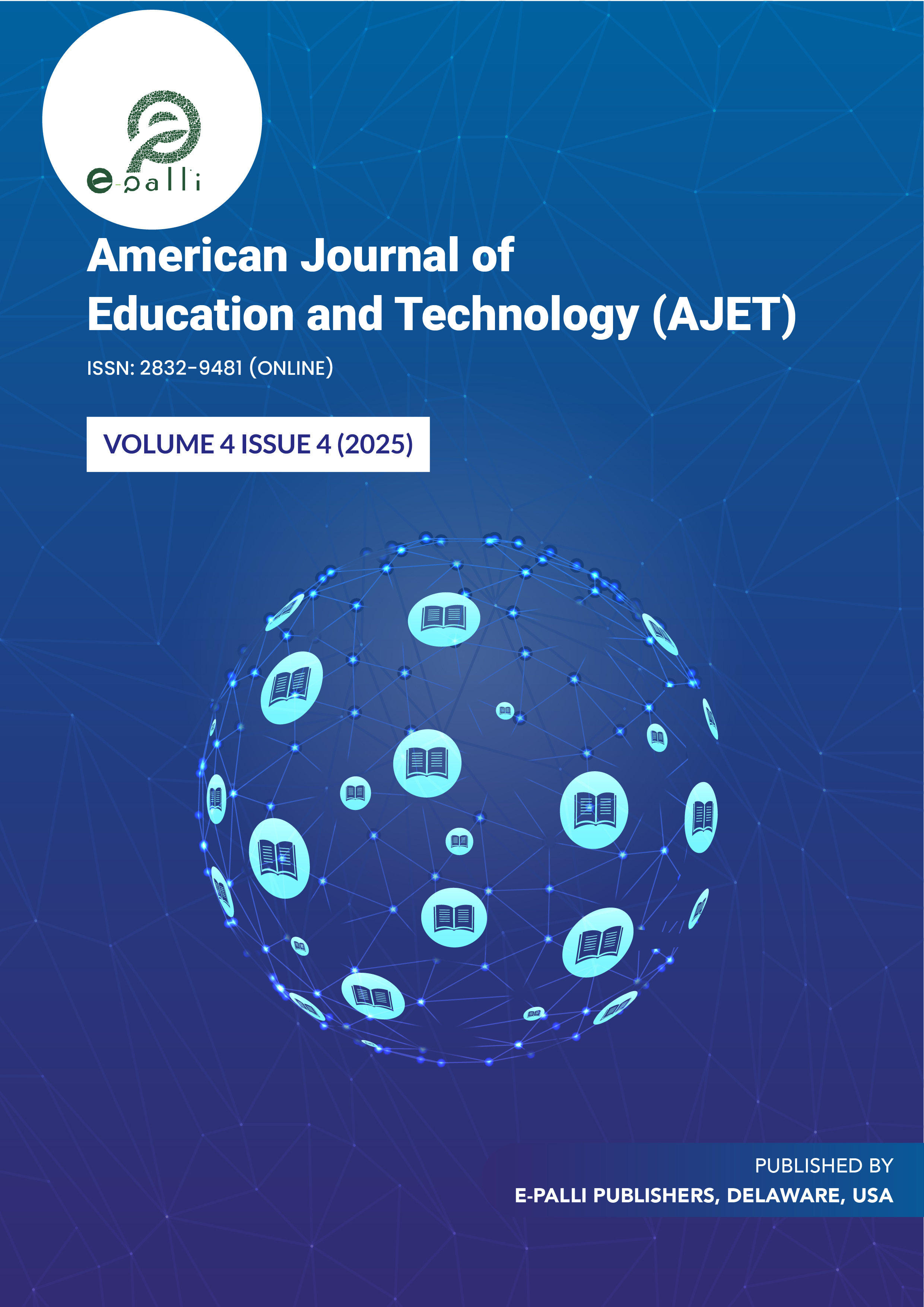The Usefulness of Interactive Whiteboards in EFL Language Centers: A Technology Acceptance Model Approach
DOI:
https://doi.org/10.54536/ajet.v4i4.5971Keywords:
EFL language centers, EFL teachers, Interactive Whiteboards, ICT, Technology Acceptance Model (TAM)Abstract
The use of Interactive Whiteboards (IWBs) in English Language Teaching has gained great interests in many countries. Teachers are utilizing this technological tool for various pedagogic purposes and in numerous teaching contexts, for its positive effect on students’ engagement and motivation. Yet, some teachers are still sceptical about the use of IWBs in their classes because of their beliefs and attitudes towards its real usefulness in the classroom. As a matter of fact, this shapes their teaching practices and governs their integration of Information and Communication Technologies (ICT). Against this backdrop, this quantitative case study aims to investigate the perceptions of Moroccan EFL teachers regarding Interactive Whiteboards in terms of Ease of Use, Usefulness and User Acceptance in the English Highway Language Centre (EH). The data was collected through the administration of a close-ended questionnaire to Moroccan EFL teachers in the same school. Then, the data was analysed through the Statistical Package for the Social Sciences (SPSS), in the form of descriptive statistics notably frequencies and percentages. Results revealed that Moroccan EFL teachers working in the EH have positive perceptions towards the use of Interactive Whiteboards (IWBs) in terms of Ease of Use, Usefulness and User Acceptance.
Downloads
References
AbhHussein, J., & Dahir, W. (2012). Teachers’ perceptions of interactive boards for teaching and learning in public and private high schools in the Arab education system in Israel.
Algarn, A. (2018). Teachers’ perceptions on the integration of interactive whiteboard (IWB) during reading instructions. https://hrmars.com/papers_submitted/6977/Primary_School_Teachers%E2%80%99_Perceptions_on_the_Integration_of_Interactive_Whiteboard_(IWB)_during_Reading_Instructions.pdf
Algarn, A. (2018). Teaching with technology in the Saudi context. https://library.iated.org/view/ALGARNI2018TEA
Bárcena, E., Read, T., & Arús, J. (Eds.). (2014). Languages for specific purposes in the digital era (Vol. 19). Springer International Publishing. https://doi.org/10.1007/978-3-319-02222-2
Belmekki, N., & Ibrahimi, E. O. (2014). The integration of the new technology at the Moroccan universities. Arab World English Journal, 16.
Bonmoh, A., Jumakate, T., & Karpklon, S. (2021). Teachers’ perceptions and experience in using technology for the classroom. Computer-Assisted Language Learning Electronic Journal (CALL-EJ), 22(1), 1–24. https://www.researchgate.net/publication/348863074_Teachers’_Perceptions_and_Experience_in_Using_Technology_for_the_Classroom
Coklar, N. A., & Kabakci, I. (2017). Discourse and Communication for Sustainable Education, 26–28.
Creswell, J. W. (2014). Research design: Qualitative, quantitative, and mixed methods approaches (4th ed.). Sage Publications.
Ertmer, P. A., & Ottenbreit-Leftwich, T. A. (2010). Teacher technology change: How knowledge, confidence, beliefs, and culture intersect. Journal of Research on Technology in Education, 42(3), 255–284.
Firman, W. M. (2007). Student perceptions of interactive whiteboards.
Hajji, K. A. (2018). ICT in education system: Comparing Morocco and Korea, 17.
Hubbard, P. (2009). Developing CALL theory: A new frontier. In Proceedings of the JALTCALL Conference, Nagoya, Japan, May 2008.
Icard, S. B. (2014). Educational technology best practices. International Journal of Instructional Technology and Distance Learning, 11(3), 37–41.
June, L., Chun-sheng, Y., Chang, L., & James, E. Y. (2003). Technology acceptance model for wireless Internet. Electronic Networking Applications and Policy, 13(3), 206–222. https://www.sciencedirect.com/topics/social-sciences/technology-acceptance-model
Muñoz-Luna, R., & Taillefer, L. (Eds.). (2018). Integrating information and communication technologies in English for specific purposes (Vol. 10). Springer International Publishing. https://doi.org/10.1007/978-3-319-68926-5
Northcote, M., Mildenhall, P., Marshall, L., & Swan, P. (2010). Interactive whiteboards: Interactive or just whiteboards? Australasian Journal of Educational Technology, 26(4), 494–510.
Oz, H. (2014). Teachers’ and students’ perceptions of interactive whiteboards in the English as a foreign language classroom. TOJET: The Turkish Online Journal of Educational Technology, 13(3), 157–174.
Rahimi, M., & Pourshahbaz, S. (2019). English as a foreign language teachers’ TPACK: Emerging research and opportunities (pp. 2–12). IGI Global.
Saltan, F., & Arslan, K. (2013). Teachers’ perception of interactive white boards: A case study. Mersin Üniversitesi Eğitim Fakültesi Dergisi, 9(2), 353-365.
Sarré, C., & Whyte, S. (Eds.). (2017). New developments in ESP teaching and learning research. Research-publishing.net. https://doi.org/10.14705/rpnet.2017.cssw2017.9782490057016
Silva, M. E., & Oliveira, M. P. V. de. (2017). The literature review of technology adoption models and theories for the novelty technology. JISTEM - Journal of Information Systems and Technology Management, 14(1), 21–38. https://doi.org/10.4301/S1807-17752017000100002
Spotts, T. H., Bowman, M. A., & Mertz, C. (1997). Higher Education, 34(4), 421–436.
Technology acceptance model (n.d.). In Foundations of Educational Technology. https://open.library.okstate.edu/foundationsofeducationaltechnology/chapter/2-technology-acceptance-model/
Zhou, G., & Xu, J. (2007). Adoption of educational technology: How does gender matter? Education and Information Technologies, 19(2), 140–153.
Downloads
Published
How to Cite
Issue
Section
License
Copyright (c) 2025 Souad Belabcir

This work is licensed under a Creative Commons Attribution 4.0 International License.








